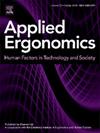Detection and management of clinical deterioration in a virtual hospital: A work system analysis
IF 3.4
2区 工程技术
Q2 ENGINEERING, INDUSTRIAL
引用次数: 0
Abstract
Timely detection and management of patient deterioration is critical to minimise adverse events and death. The study aimed to understand the processes of detecting and managing deterioration in a virtual care environment, assess work system barriers and facilitators, and identify changes needed to the technology. Data were collected using interviews and document reviews and presented as process map and a work system analysis. We found that nurses and patients were key stakeholders in detecting deterioration, while management of deterioration was primarily performed by doctors and patients. We uncovered more barriers in the detection process than the management process, with the majority of barriers relating to technologies. Most facilitators related to people and included clinician expertise and carer support. Duplication of work and difficulty assessing some signs virtually were also revealed as barriers to the deterioration detection process. This study led to work system changes to mitigate some of these barriers.
虚拟医院临床恶化的检测与管理:工作系统分析
及时发现和管理患者病情恶化对于尽量减少不良事件和死亡至关重要。该研究旨在了解在虚拟护理环境中检测和管理恶化的过程,评估工作系统的障碍和促进因素,并确定技术所需的变化。通过访谈和文件审查收集数据,并以流程图和工作系统分析的形式呈现。我们发现护士和患者是发现恶化的关键利益相关者,而恶化的管理主要由医生和患者进行。我们在检测过程中发现了比管理过程更多的障碍,其中大多数障碍与技术有关。大多数辅导员与人有关,包括临床医生的专业知识和护理人员的支持。重复的工作和难以评估的一些迹象实际上也揭示了恶化检测过程的障碍。这项研究导致了工作系统的改变,以减轻这些障碍。
本文章由计算机程序翻译,如有差异,请以英文原文为准。
求助全文
约1分钟内获得全文
求助全文
来源期刊

Applied Ergonomics
工程技术-工程:工业
CiteScore
7.50
自引率
9.40%
发文量
248
审稿时长
53 days
期刊介绍:
Applied Ergonomics is aimed at ergonomists and all those interested in applying ergonomics/human factors in the design, planning and management of technical and social systems at work or leisure. Readership is truly international with subscribers in over 50 countries. Professionals for whom Applied Ergonomics is of interest include: ergonomists, designers, industrial engineers, health and safety specialists, systems engineers, design engineers, organizational psychologists, occupational health specialists and human-computer interaction specialists.
 求助内容:
求助内容: 应助结果提醒方式:
应助结果提醒方式:


